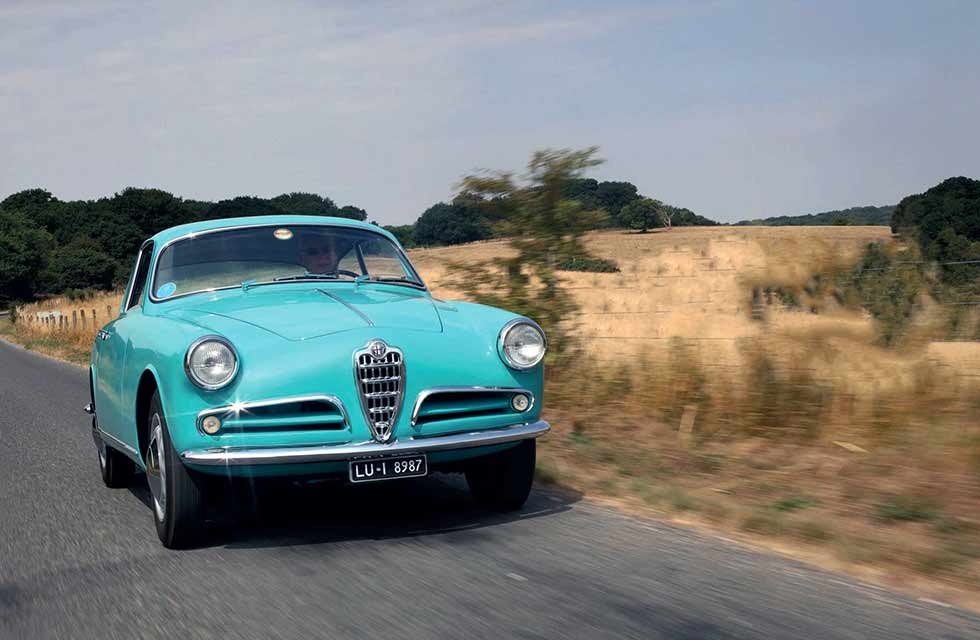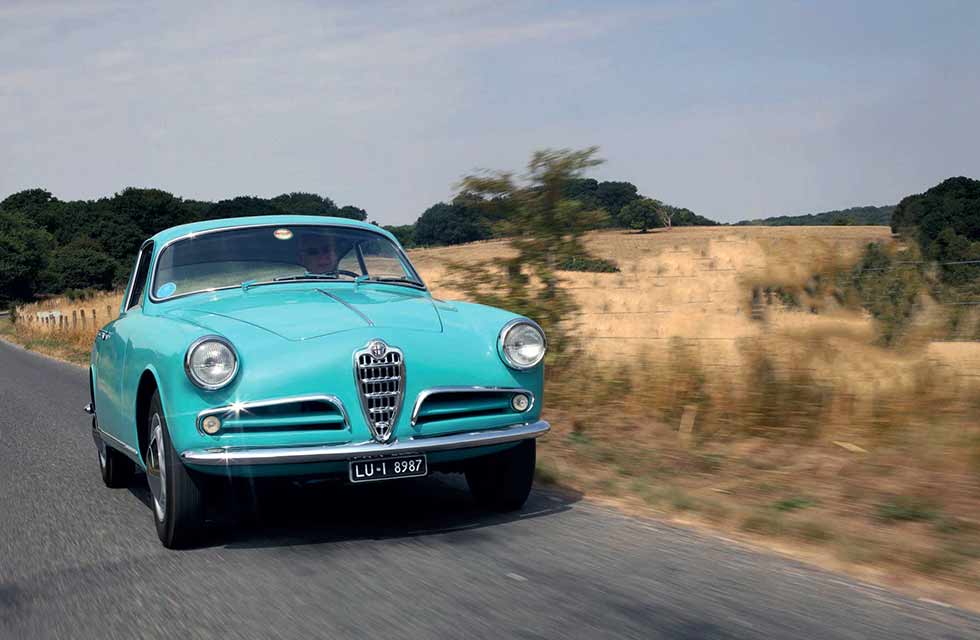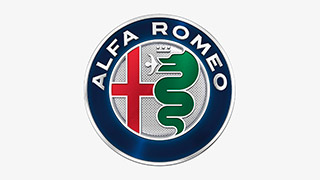
A passion for imperfection. It takes a special owner to fastidiously restore a rare classic – but then this Alfa Giulietta Sprint is like no other. Words Mick Walsh. Photography James Mann.
RARE ALFA GIULIETA PROTOTYPE’S REVIVAL / GIULIETTA REBORN Mick Walsh samples a rare prototype of Alfa Romeo’s benchmark coupé
Most major restoration projects are a challenge, but when a car is the oldest-surviving example with hundreds of handmade, preproduction differences the task becomes much more involved, as Alfa Romeo enthusiast Paul Gregory discovered.

When a blue Giulietta Sprint prototype was launched to the public in April 1954 at the Turin show, Alfa had no idea of the demand the brilliant 1290cc, 65bhp GT would achieve, and after a few days orders had to be suspended. To cope with the overwhelming sales, the car was rushed into pre-production late in 1954 with a series of handbuilt cars co-produced by Alfa, Bertone (bodywork) and Ghia (interior and electrics).
Later builds focused around Bertone, with work subcontracted to myriad artisan specialists near Turin, before a new production facility was completed at Grugliasco. To raise extra funds, even a bond ticket scheme was set up for early orders, with a blindfolded boy drawing out the numbers before the press.
How many of these so-called ‘transition’ Giuliettas were built remains a mystery, with estimates ranging from 200-1000. Chassis 24, the turquoise beauty featured here, is believed to be the oldest survivor and has body number 16 stamped and etched all over its inner skin.
It might initially look like a standard early Sprint, but details such as the lower roof, curved rear wheelarch and lack of badging give clues to a fascinating history that includes an order from a young Swedish racer called Jo Bonnier. The 25-year-old came from a wealthy publishing family and, after studying at Oxford for a year, he had decided to pursue a motor-racing career as well as dealing in sports cars in Sweden. The determined youngster already had links with Alfa, having ice-raced and rallied various 1900s including a Disco Volante, and later drove a Giulietta Sprint Alleggerita on the 1956 Mille Miglia, the year he entered Formula One.
From its completion date on 5 January 1955, the early history of 00024 remains a mystery. After his order was confirmed, Bonnier waited until May before his mechanic KG ‘Kage’ Kanrell drove the dazzling new Giulietta back from Italy on Milan plates. The compact Blu Chiarissimo coupé was probably the first in Sweden, and no doubt created a stir around Stockholm before Bonnier sold it to Ivan Blom, a wealthy company director, well known in Swedish racing circles. “We think it was used by Bonnier for demonstrations, but we found no evidence of competition,” concludes Gregory.
Frustratingly, Stockholm registration records were destroyed in ’1955, but with the help of local Alfisti, Gregory has pieced together its ownership history. In 1963, 00024 was acquired by Bo Dahlström, a Stockholm-based local who lived life to the full, taking the Alfa on various dates, but over the winter he rolled it on snow-covered roads. The Giulietta wasn’t badly damaged, but during the body repairs it was resprayed a different blue and retrimmed. Over the years the car was upgraded to later specification including the engine, while a floor-mounted five-speed gearbox replaced the column change before it was taken off the road in the 1980s.
As with so many restoration projects, this Giulietta Sprint found saviour Gregory almost by accident. Since 1971 this respected engineer has been addicted to Alfas, starting with a ’64 Giulia Sprint GT: “I was looking for something more practical for my commute and spotted it in Exchange & Mart. I later rebuilt the engine in the kitchen. Like all Alfas it was mechanically wonderful but the body started crumbling away.
My friend Nick Savage introduced me to earlier Giuliettas and I’ve been hooked ever since. For me it’s a nicer car than a 105 series. With just enough grip to be involving but not at stupid speeds, it’s the perfect package. Great engine, good brakes, superb steering and beautiful aesthetics. From just 1290cc, it’ll pull over 100mph and cruise happily at 80mph.”
Gregory’s passion for Giuliettas eventually led to him editing the club magazine and his election to club chairman. Holding that dedicated position meant he received telephone calls from members right across the world, including several from Sweden: “In 2006 I was contacted by Axel Lind from Sävedalen, a suburb of Gothenburg. He phoned to say he had a very early Sprint and needed a valuation. My estimate for insurance had been generous, and 12 months later Axel made contact again to report that he was thinking of selling the car.”
The idea of an early car appealed and immediately Gregory contacted specialist Chris Robinson and pal Savage about a trip to Sweden to investigate: “It was just as Axel had described the condition. Someone had started the restoration in the 1970s but thankfully hadn’t spoilt the car. I had no idea I was about to become a self-confessed anorak on the early cars, but the process of learning has been great fun.”
The handmade early construction became very clear as soon as the paint was removed from the bodywork: “The standard of workmanship was high and very labour-intensive. The body was made of fabricated panels, which were skillfully formed and welded together. Once stripped, all the body pieces and fillets of beaten and shaped metal became clear. For reference, we marked out all the sections for a photograph to record the construction.”
John Holden of The Old Coachworks in Over Wallop took on the task of the bodywork, where Gregory’s biggest challenge was to convince this perfectionist not to improve on the original workmanship. “The body was sandblasted because I didn’t want to dip it,” says Gregory.
“With none of the structural members of the later production Sprints it was a little floppy, but from the start we decided to return it as closely as possible to the original specification, just as it left Carrozzeria Bertone. Ultimately that task was fascinating and frustrating in equal measure.”
The rebuild quickly revealed the nature of its construction, with surprising bodges in previously unseen places, such as the front bumper brackets and floor. From the fabricated chassis legs and front frame to the flat sheet for the rear bulkhead, the secrets of its hand-crafted inner structure were revealed: “There’s little stiffening and even the tops of the shock-absorber columns just used folded metal for reinforcement. The inside of the boot was really patchwork, and the simple door construction was folded box-sections. The propshaft cover had been crudely hammered down just to make the seats fit properly.
When the door trims were remade, we also discovered that the door lengths differed by 10mm on each side. It pained John to leave such bodging in the interests of preservation.” Once the body was repaired, the shell was sent to Sean Watson, also of The Old Coachworks, for the paintwork to be done. Although the car had been resprayed blue and later red, evidence of the bold original Blu Chiarissimo (clear blue) was discovered inside the glovebox. “We tracked down the original code, AR310, which turned out to be a pretty lively blue with a hint of green,” says Gregory. “I was apprehensive about the tone at first, but since it was sprayed in authentic Lechler cellulose and fitted out with the grey trim, I’ve grown to love it.”
The interior’s unique details provided more challenges but, although the door panels had been changed, the original seat frames and covers were discovered underneath a later retrim. “The style was unique to the first 100 cars,” says Gregrory. “We sent the sample to Humphries Weaving of Sudbury, who did a superb job of remaking the fabric. None of the carpets were left so these also had to be remade using early photographs. The headlining and sunvisors were trimmed with grey cloth.” With the distinctive early-style, body-coloured painted dashboard and lower-hinged glovebox, the finished result looks very stylish. You can just imagine the reaction on opening the door on the Alfa stand when the prototype Sprint was unveiled at the Turin show in April 1954.
The windscreen for the early cars is a different size due to the lower roof profile and the higher bottom edge. The missing front glass had to be specially formed by Pilkington Automotive’s classic department on the Isle of Sheppey: “They were really helpful. The first attempt didn’t quite fit. We took it back several times so they could grind off more glass and put it back in the oven for a few days to reshape it.” The green-tinted rear screen thankfully just required a polish, but all the sides were too scratched, and had to be recut. For the final touch, the ‘Vitrex’ logo was etched into the replacement windows.
The next challenge was the engine because the original had long since been replaced. Again the casting of the early 750 series is different, with narrow vertical strengthening ribs, unique front cover stud spacing, and a contrasting back-plate: “As with many of the Giulietta’s revisions, changes were made following customer problems. Thankfully, I eventually found an early block in Italy through Claudio Giorgetti.”
Gregory’s pursuit of authenticity continued throughout the mechanical specification. A Solex 32PAIAT twin-choke carb was sourced, but the early manifold had to be made from scratch using factory drawings and photographs: “We knew it would hamper performance, but it had to look correct. Solex 32 parts also proved difficult, so we’ve now made our own jets. To complete the engine bay I really wanted an early coal-scuttle-style air cleaner rather than the later canister type. Again, my Swedish friends came to the rescue. Chris Robinson did a super job of rebuilding the engine while I set about the challenging task of finding parts.”
The first Giulietta Sprints had a cable-pull starter mounted under the dash, so Gregory had to fit this early design. Setting up the starter pinion slide to engage the flywheel proved difficult: “There’s no Bendix, and after careful adjustment we finally sorted it. It soon became clear why the design was superseded.” Another mystery feature of the early Giuliettas was the fitting of Lucas electrics including dynamo, distributor, coil and starter: “It’s amazing that Alfa didn’t use an Italian supplier such as Magneti, but maybe timing was the problem.
Early engine photos show the coil mounted on the front of the head, but during testing the factory quickly found that heat and vibrations caused problems. This was soon replaced by the fuel pump high at the front of the engine. We’ve retained this but to make it more driveable we’ve fitted a modern pump at the back to avoid problems with vapourisation and modern fuels.”
For the wheels, the Fergat Torino original specification was restored. These feature rolled rims, which were used up to 1955 but were later changed by Alfa Romeo due to corrosion problems. A successful search for a set of early hubcaps with 72mm badges was another final detail to complete the project. Cosmetic touches included making a toolkit bag after sourcing original-style canvas and tracking down a set of factory tools at considerable cost. “I’ve bought cars for less,” jokes Gregory.
“A Giulietta Register member kindly found me an original provvisorio instruction manual, while Claus Menzel helped source a correct original jack.” The final touch was a set of period-style Italian plates sourced via an American specialist based in Florida.
There was further fettling until the historic day when 00024 drove for the first time in four decades: “After some fine-tuning to the ignition and the jetting on the Solex carburettor it ran well. With the small-bore exhaust system it produced a lovely note. Chris wanted to upgrade the suspension, but I love the soft ride quality. The column change is a little rubbery, but with additional miles it’s getting better.”
Gregory and Robinson clocked up the first 400 miles on local Hampshire roads as the debugging continued. Again the determination to keep the car authentic proved a challenge: “A frustrating vibration was traced to the propshaft fork support. The centring design was made of aluminium, which was later superseded by a stronger steel version. Again it would have been easy just to modify but, amazingly, AFRA sourced an original replacement.” Where Giorgetti finds these incredibly rare parts is a mystery, but his AFRA family business in Milan has links to Alfa that date back to 1946.
The restored car is still running in, with a rev limit of 3500rpm, so the performance has yet to be fully tested: “It’s frustrating because this is the point at which the engine comes on cam. The early cars were considerably lighter than the production versions and it will be fascinating to finally get it on a weighbridge. At some stage the car was fitted with a 10/41 back axle which might prove a little sluggish with just 65bhp, so I have a replacement 9/41 on the shelf just in case.”
Since completion, 00024 has been proudly exhibited in the rotunda at the RAC’s Pall Mall Clubhouse, where it was much admired. Other outings have included the Concours of Elegance at Hampton Court Palace, but Gregory’s not a concours man and has always preferred using his cars: “The predicament is that it’s too important a car to use as a daily driver. It really should be displayed in the Alfa museum at Arese, but I hate the idea of it being locked up.”
So far it appears that 00024 is the earliest survivor of the first batch of Sprints: “Ten cars were completed before mine, and nothing has popped up yet. But you never know – there could still be one out there stashed away in an Italian barn.” Collector Corrado Lopresto has chassis 002, but this is little more than a chassis plate because the car was reshelled in 1958 by the factory and rebuilt to Veloce specification for Eduardo Weber. The general opinion is that this was a tax dodge for a trusted supplier.
The ultimate future of this beautiful car is undecided. For now, Gregory and his talented team of specialists should feel very proud of their achievement. The decade-long project is the perfect tribute to the original design team, engineers and artisans who created a car that changed the course of Alfa Romeo’s history. Every one of chassis 00024’s early handmade features tells a vivid story, and the dedication to preserve them says everything about Gregory’s inspiring passion for Giuliettas.
‘Details such as the lower roof, curved rear wheelarch and lack of badging give clues to its fascinating history’
‘Our’ car is one of these Bertone shells being prepared in December ’1954. Above: Lucas electrics mimic those of the original. Paul Gregory’s attention to detail is second to none and it has handsomely paid off in this labour-of-love project, which has taken 10 years to complete.
Italian-style numberplate is the icing on the cake. Right: period-correct luggage adds to the look. Above: dapper owner Bo Dahlström pictured in ’1963. Body-coloured dashboard and lower-hinged glovebox mark out this chic coupé as a very early example; column gearchange has now been reinstated.






